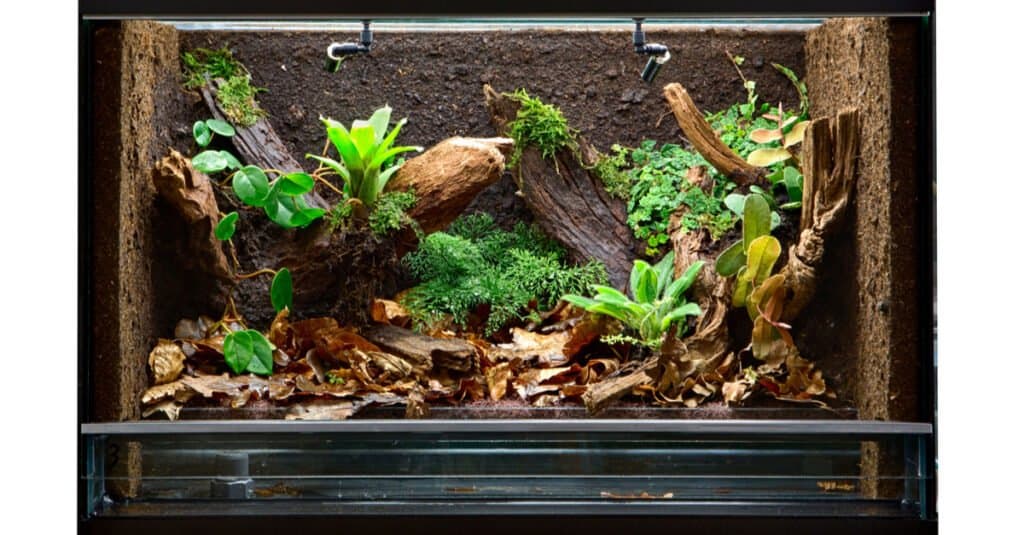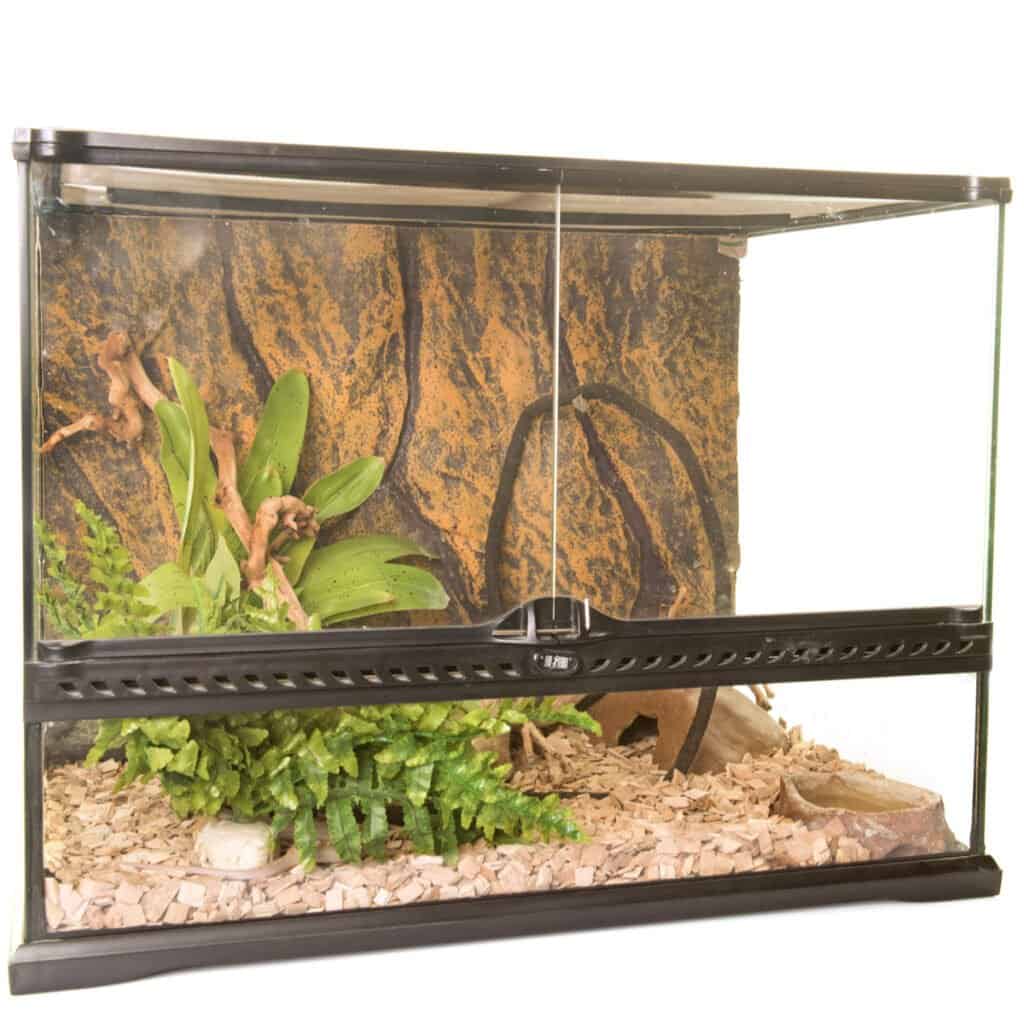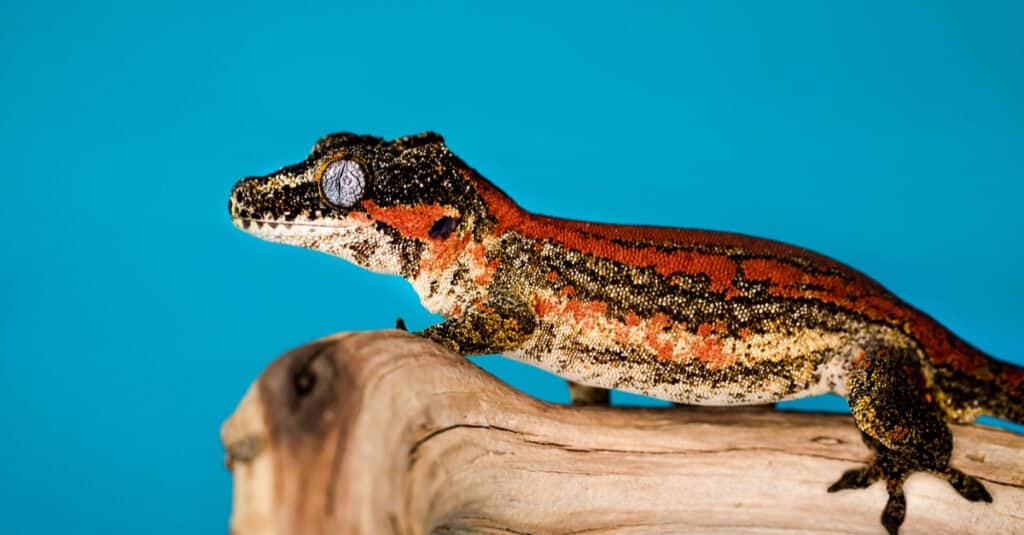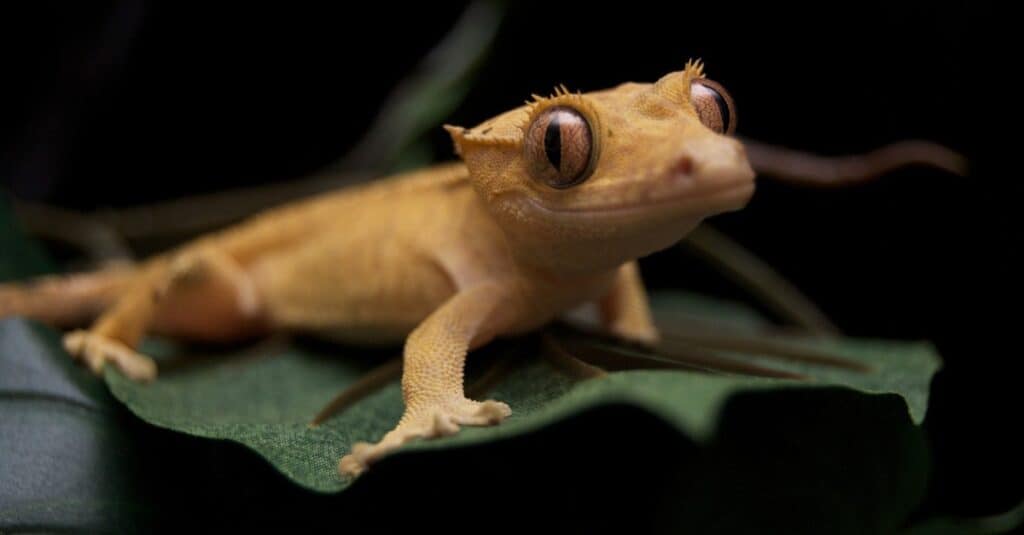Like with any pet reptile, a crested gecko needs a proper enclosure. A sturdy, safe enclosure will allow you to replicate the gecko’s native habitat in a small, confined space so your new pet feels comfortable. What’s more, an enclosure doubles as a stunning display in your home so you can show off your gecko to friends and family!
However, with so many unique reptile enclosures on the market, choosing the right one can be challenging. Let’s take a look at what your crested gecko’s tank should look like, how much space your scaly friend needs to thrive, and what sort of supplies the enclosure needs for a proper setup.
What Size Enclosure Does a Crested Gecko Need?

Crested geckos need enclosures that are taller than they are wide.
©Dirk Ercken/Shutterstock.com
The ideal enclosure size for a single crested gecko is 12” x 12” x 18”, or slightly more than 10 gallons. However, larger is always better if you can afford it!
If you want to house two or three geckos in one enclosure, the tank should be at least 18” x 18” x 24”. This size equates to just under 30 gallons, so each additional gecko should get at least an extra 10 gallons of space. Regardless of the size you choose, the enclosure should always prioritize vertical space over horizontal space. This simply means the tank should be almost twice as tall as it is wide.
Unlike the more terrestrial leopard geckos, crested geckos are arboreal lizards. Because of this trait, cresties spend most of their time climbing high up in trees in their native rainforest habitats. Similarly, they prefer having lots of room to climb in captivity!
Keep in mind this doesn’t mean the enclosure doesn’t need substrate, though. Occasionally, your gecko will come down to the floor of the enclosure, and they’ll need something comfortable and safe to walk on.
What Enclosure is Best for a Crested Gecko?

A tall, sturdy, glass enclosure is best for a crested gecko.
©cynoclub/Shutterstock.com
Like we touched on earlier, a tall enclosure with more vertical than horizontal space is best for a pet crested gecko. The tank should be sturdy and ideally made of strong, transparent glass. Glass enclosures are the most common on the market, and for many good reasons! They are inexpensive yet durable and well-insulated, so they maintain heat and humidity well.
It’s also a good idea to look for an enclosure with large doors either on the front or side of the tank. These easy-access doors make cleaning the tank and examining your gecko easy and convenient. You should be able to securely shut and lock the doors so there are no escape attempts while you’re not around. Some enclosures also have screened lids on top that you can slide open if necessary.
There are many great brands on the market that sell inexpensive yet high-quality enclosures designed specifically for crested geckos. REPTIZOO, Zoo Med, and Zilla are all excellent choices. Their products are available at pet shops and most online retailers at very affordable prices.
Of course, you could also custom-build a unique enclosure of your own! There are plenty of guides and patterns available online for elaborate gecko enclosures with detailed instructions. However, this isn’t recommended for beginner reptile owners unless you have experience building these kinds of tanks or know an expert who can help you through the process.
How Much Do Crested Gecko Enclosures Cost?

A single crested gecko needs an enclosure of at least 10 gallons in size.
©EWStock/Shutterstock.com
A typical 12” x 12” x 18” (roughly 10 gallons) glass enclosure usually costs anywhere from $100 to $200. If you want something a bit larger, an 18” x 18” x 24” enclosure (roughly 30 gallons) will cost about $200 to $300.
Keep in mind these sizes and prices are general estimates. Additionally, the enclosure doesn’t necessarily have to have these exact dimensions. Any enclosure at least 10 gallons in size with more vertical than horizontal space will be sufficient for a single gecko. Simply add on another 10 gallons for each additional gecko you plan to add to the enclosure.
Some enclosures come with starter kits designed specifically for crested geckos! These are often available at pet shops at a lower price than it would be to purchase the enclosure and all the supplies separately. The supplies included vary, but many come with lighting, substrate, artificial plants, and even dual thermometer/hygrometers. These starter kit enclosures can vary in price from around $200 to $400 or more, depending on what supplies the manufacturer has included.
What Do Crested Gecko Enclosures Need?

Your gecko’s enclosure needs plenty of platforms, vines, and plants for your gecko to climb on.
©iStock.com/ajbulla
Your crested gecko’s enclosure is only the first part of their new habitat under your care. Once you’ve purchased a suitable tank, you’ll then need to furnish it and ensure the heat and humidity settings are within a safe range for your pet.
The main supplies you’ll need for the enclosure are:
- Heat/visibility lighting. A white, low-wattage daytime basking bulb (40 to 60 watts) is best. Daytime temperatures should be between 74F and 78F with a small basking spot of around 80F. It’s safe for temperatures to dip to 70F at night. Remember to purchase a fixture to house the bulb and its eventual replacements.
- UVB lighting. While UVB lighting isn’t necessary for your gecko’s survival, it’s still beneficial to their health, growth, and digestion. A bulb with a 3% to 5% output is ideal. This bulb will also need its own fixture.
- Substrate. This is the material you’ll use to cover the floor of the enclosure. Use something that maintains humidity well, like coconut fiber, sphagnum moss, or potting soil.
- Vines, branches, hides, ledges, etc. Since crested geckos love to climb, their enclosures need plenty of platforms, hides, and plants for them to explore. Many artificial plants and vines sold for reptile enclosures come with suction cups so you can easily adhere them to the enclosure’s walls.
- Food and water dishes. These should be small, sturdy, and nonporous.
- A thermometer/hygrometer. These usually have suction cups on the back so you can stick them to the walls of the enclosure. Humidity should always be between 60% and 80%.
- Something to mist the enclosure with. A simple misting spray bottle works best. You can also buy elaborate automatic/timed misting systems for more convenience, but this isn’t necessary.
The photo featured at the top of this post is © iStock.com/ajbulla
Thank you for reading! Have some feedback for us? Contact the AZ Animals editorial team.







